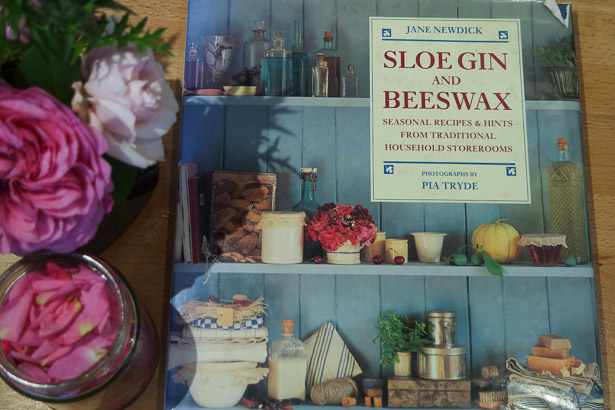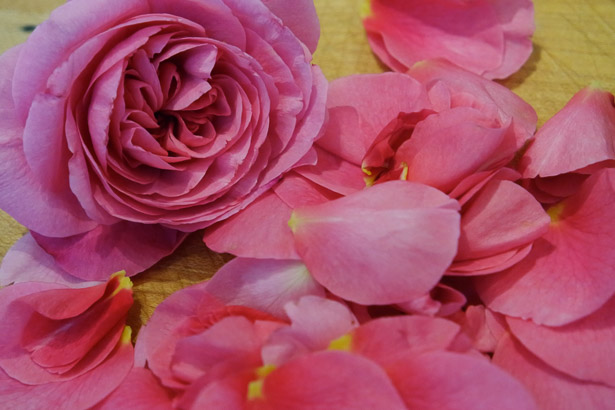Saying Yes is often uncomfortable. But I’ve learned that things that intimidate me often end up being my greatest pleasure. I’ve found how much more in life there is to enjoy if I open myself up to a little bit of unease and discomfort. (Hey, I didn’t like my first taste of gin, but like a good trouper, I kept at it …)
Right now I’m sitting next to a vase of the most fragrant, beautiful Old English roses. I love the smell, I love the look, I love the romance of roses. Roses make me feel elegant just looking at them.
Even so, because of the roses, my nose is sniffling and my eyes are itching. But roses are something I always want to say yes to. So I have to say yes to hay fever as well.
I’ve heard that, when you have hay fever, you can rid yourself of it homoeopathically by eating a teaspoon of local honey every day for a year, kind of like a vaccine. So I’m hoping that pickling rose petals and having them throughout the winter will do something similar for me. But to be honest, when I decided to make them I had only a vague idea of how I will use them later. I couldn’t really see myself eating a spoonful of flowers every day, no matter how much I might love them.
But once I put everything together, the smell was so intoxicating that i was able to see plenty of uses: scattered over a dish of Moroccan slow cooked lamb, or incorporated into a citrus and date salad. Whatever I do, I’m hoping that although the day will be grey, the taste will be bright, and we will eat and remember the warm summer sun playing across our shoulders.
Picked Rose Petals
adapted from Sloe Gin and Beeswax, by Jane Newdick
My sister-in-law Tabby always gives great presents. She seems to really think about the recipient and what would bring them joy. She often makes exquisite presents, which The Author and I are thrilled to receive. But one of the best store-bought presents she ever gave me was the book Sloe Gin and Beeswax. I have relished this book from the minute I opened the cover. Not only does it have delightfully beautiful photography in it, but the photos are accompanied by traditional, almost forgotten recipes for tinctures, balms, cookies, preserves, lotions, and yes, sloe gin, among other things.

The other day I picked up the book, looking for a recipe for rose petal jam, and I have yet to find one; once I got to the page with pickled rose petals, I didn’t want to look any further. I had no idea what to expect, but I gamely picked some of our roses and pulled off the petals as instructed. When I got to the sugar and vinegar part of the recipe, I can’t say that the mingling smells gave me much hope. When I mixed the liquid with the rose petals, however, I was totally taken by the perfume and the sheer uniqueness of it all.
The sweet and sour rose flavoured syrup is divine, although I do have some doubts about how the rose petals will fare over the next few months. I just checked them earlier today, and they had all floated to the top of the jar and formed a mass, like algae bloom on a pond. I poked them and broke the structure up a bit, and tried to get them all free-floating in the syrup. Only time will tell if this works.
If you want to experiment along with me, here is the recipe, as adapted.
- unsprayed, old variety roses (the kind with the most beautiful and intense scent!)
- sugar
- white vinegar
Pick the flowers first thing in the morning if possible, for the strongest scent. Gently pull the petals off the stamen.
Weigh the petals and set aside. Newdick says to weigh out an equal amount of sugar and vinegar. For the amount I had, I used 39g of sugar and 39ml of white vinegar. I can tell you that this was not nearly enough; I ended up tripling the syrup part, so my advice is to use three times the weight of petals for your sugar and then use the same ratio for vinegar.
Heat the vinegar and sugar in a saucepan, stirring constantly, until the sugar has melted. Take off the heat and let the syrup cool. In the meantime, pack the rose petals into a jar – it should be a dark or opaque glass so the petals do not lose their colour as they age.

Because I was trying to get the petals submerged without making more syrup, I ended up bruising them a bit. I wised up and made more syrup, but I’m hoping the slight crushing will make them better in the end.
When the syrup is cool, pour it into the jar, ensuring that the petals are submerged. Inhale deeply, because this is where it really starts to become more than the sum of its parts.
Put the lid on the jar, label it, and set it aside for a few months. Let’s check back then, shall we?






Tara,
This is intriguing.I am going to try, too, but I’ll have to wait a week or more. Our roses are past their first bloom and we’re waiting on the second. With the drought and all here in Cali, we’re not watering much.
That books sounds great. Wonder if it is published in the States?
I’ve got a lot of lavender, too, just saying, if you happen to get inspired in that direction. I am wanting to use some soon, because we have to dig it up and move it – It’s too close to our front door and draws too many bees, which is good for the bees and the environment but bad for my kids who are both allergic to bee stings – and don’t know if it will survive.
I’ll let you know how the pickled rose petals go.
Maria
Maria
LikeLike
Maria, I LOVE lavender! I sometimes use it in shortbread, and I’ve made little sachets for our drawers to keep bugs at bay, but other than that I think I’m under-utilising it. I’ll see what I can find.
Also, I think you can get Sloe Gin and Beeswax on Amazon. It seems to be mostly shipped from the UK, and I found a first edition copy that was over £1000, but many used for £1 or less. Because it was published in the UK and it’s now out of print, I think you would have a hard time finding it in the States, even in a used bookshop.
xo
LikeLike
Pingback: Harissa, Rose Petals & Cereal Woes (a snapshot of life) | Little Home Kitchen
Pingback: How To Make Essential Oils At Home | Homesteading Skills
Pingback: How To Attain Essential Petroleums At Home | Homesteading Skills – Homestead Survivalism
Hi Tara
Just stumbled across this post and 6 years later I’m wondering how it turned out?!
Would love if you could point me in the right direction to a follow up post or let me know if you remember!
Many thanks and all the best,
B.
LikeLike
I ended up using it on some spicy chicken, Moroccan style roasted chicken.The flavours were amazing. I do have to say, though, the petals themselves are not appealing, and we didn’t want to eat them. The syrup is the stuff!
LikeLike